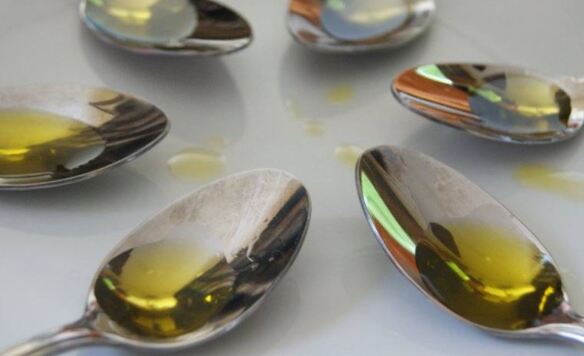|
There are many chemical compounds that make up the flavour of Extra Virgin Olive Oil. In some spices, cinnamon for example, there is just a single compound – cinnamaldehyde which imparts a strong smell of cinnamon. It would be nice to be able to identify a single chemical which would tell us whether it is a great olive oil, or not, by a single test. However because of the complexity, we will always need tasters. The interaction of these chemicals together, contribute to its flavour.
Naturally occurring aroma compounds; Aldehydes, alcohols, esters, hydrocarbons, ketones, furans, as well as others, have been identified by gas chromatography and mass spectrometry in good-quality olive oil. Over one hundred such compounds have been identified which, as a whole, contribute to the characteristics which make extra virgin olive oil unique. These tastes and fragrances derive from compounds like hexanal (green, grassy), trans-2-hexenal (green, bitter), and 1-hexanol and 3-methylbutan-1-ol, which are the major volatile compounds of olive oil. Many of these flavour compounds decompose if temperatures during milling are too high. Oleocanthal and oleuropein may cause a bitter or peppery taste, tingling or burning sensation or may cause slight numbness. Some people promote the idea that more pungency is better and consumers have been told that they should ONLY seek out very bitter, peppery oils or else they are being "duped." This is completely untrue. Phenolic compounds also have a significant effect on olive oil flavour. There is a good correlation between aroma and flavour of olive oil and its polyphenol content. Hydroxytyrosol, tyrosol, caffeic acid, coumaric acid, and p-hydroxybenzoic acid influence mostly the sensory characteristics of olive oil. Various off-flavor or rancidity compounds are formed by oxidation, which may be initiated in the olive fruit. Pentanal, hexanal, octanal, and nonanal are the major compounds formed in oxidized olive oil, but 2-pentenal and 2-heptenal are mainly responsible for rancidity. Oleic acid is often thought to be the peppery taste in olive oil. It is not. Different olive oils with the same amount of oleic acid may be quite peppery or not all. Many studies have been done to try to predict a flavour profile based on the oil's chemistry. In "The Handbook of Olive Oil" by Harwood and Arapicio, they cite studies done by the authors that show that aglycons are responsible for the bitter and pungent sensory attribute, as well as tyrosol and possibly alpha-tocopherol. The phenols are related to astringent attributes. It is probably the combination of bitterness and astringency that causes a person to cough. Many factors influence the presence of these compounds, in particular:
When tasting olive oil, much of the oil’s characteristics are perceived through the sense of smell. Though most people enjoy olive oil with other foods, the following steps allow us to focus on the olive oil’s flavour without distraction:
Some desirable traits you may smell/taste in an olive oil are: Apple/Green apple which would be indicative of certain varieties of olives. Bitter which is considered a positive attribute because it means the oil is fresh. Buttery, fruity, grassy, peppery and tropical are all attributes that are seen as positive in a tasting. Some undesirable traits when tasting are: Blue cheese – an aroma associated with muddy sediment effect, Dreggish – an odour of warm lubricating oil caused by poor execution of the decanting process, Fusty which is an anaerobic fermentation that occurs when olives are stored in piles too long before being pressed and Rancid – when an oil has oxidated as it ages and is often described as stale nuts.
0 Comments
Leave a Reply. |
AuthorChris Piper Archives
June 2024
Categories |


 RSS Feed
RSS Feed